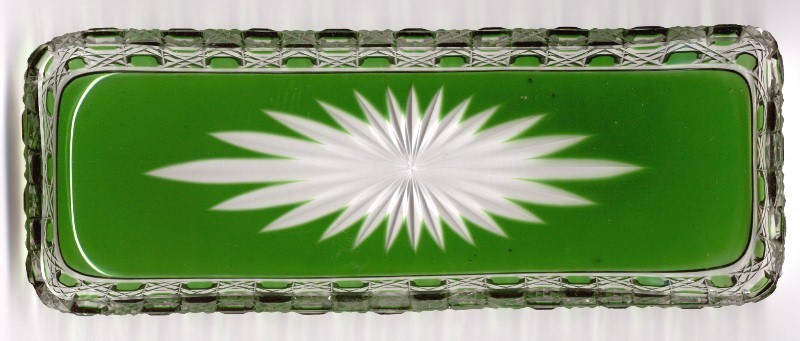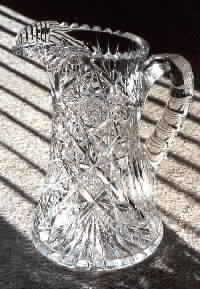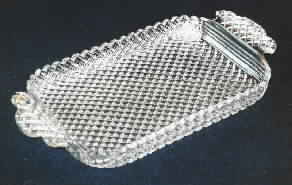| American Brilliant Period Glass: Affordable Victorian Elegance | ||
| by Christopher and Marie Kierkus | ||
| What to Look For (Part Two): Special Considerations | ||
| |
||
| Signed vs. Unsigned ABP glass | ||
| |
||
| The majority of early ABP glass was unsigned. Few companies manufactured the glass and its quality was uniformly high. However, at the height of the brilliant period (1900-1910) a large number of small cut glass companies entered the market. Many of these produced mediocre quality glass (acid polished with simple geometric patterns). To differentiate their products from these lower quality pieces, prominent companies such as Hawkes, Libbey, Hoare, Dorflinger, Sinclaire, Bergen, Pitkins and Brooks, Meridien, Tuthill and Clark started to "sign" their pieces by dipping a stamp featuring the company logo in acid and applying it to the glass. This left a faint, opaque white symbol on the finished piece. | ||
| |
||
| Cut glass signatures are difficult to detect and appear in many different places. However, some locations are more common than others. Bowls, dishes and bon-bons are frequently signed on the inside center. Handled pieces often have a signature on the top, flat portion of the handle. Vases, cordials and decanters are usually signed on the underside of the base. Signed pieces typically sell for 1.5 to 3 times as much as comparable quality unsigned pieces. Signatures that help authenticate rare, intricate pieces are generally the most valuable. However, for the same reason, collectors should beware of buying an expensive piece simply on the basis of a signature. Signatures have been forged by duplicating the original acid stamp process or by "scratching" the signature into the glass with an electric needle. Consequently, we would recommend that collectors select pieces on the basis of their intrinsic beauty and quality. Consider a signature an "added bonus" but do not buy a piece simply because it is signed. | ||
| |
||
| Colored and Cut-to-Clear vs. Clear ABP glass | ||
| |
||
| The vast majority of ABP glass (95% +) was cut on clear glass blanks. A very small minority was cut on colored blanks or blanks that had a colored layer of glass applied over a clear foundation. The later type are called "cut-to-clear" pieces because cutting creates a clear pattern set against a colored uncut surface. Because of its rarity, colored and cut-to-clear ABP glass commands a substantial premium over clear pieces (typically 3 to 10 times the price). However, the aspiring collector should be aware that most of the cut-to-clear glass that is available on the market is not ABP. Most glass of this type was produced in Europe. In fact, it is still being produced today. | ||
| |
||
| The colors on European cut-to-clear glass tend to be very dark and vivid whereas ABP pieces are more subtle. The majority of ABP cut-to-clear glass was cut on medium green or red overlaid blanks while Europeans cut many dark blue (cobalt) or dark red (ruby) pieces. Most European patterns are fairly simple and the pieces have a thin overlay layer that exhibits "bleeding" between the colored and clear layers of glass. The boundary between the colored overlay and the clear layer on an ABP piece should be razor sharp and the layer should be substantial. | ||

| A Rare, Green Cut-to-Clear Tray in the Hexagon Cane Pattern (circa 1890-1905) | ||
| The pattern, thickness of the overlay layer and wear marks help authenticate this piece. | ||
| (estimated retail value: $400-$600) | ||
| All glass vs. Glass and Silver pieces | ||
| |
||
| A reasonable number of ABP pieces were embellished with silver. This was especially true of pitchers, salt and pepper shakers, powder boxes and syrup jugs. Some bowls, decanters and cruets also have silver rims or stoppers. Silver embellishments were manufactured from Sterling silver (i.e. silver with a purity level of 92.5% +) or silver plate (a thin silver layer over a "base" metal such as copper). Pieces embellished with sterling silver typically cost 1.5 - 3 times the amount of all glass pieces (depending on the quality and detail in the silver work). Pieces embellished with silver plate usually do not command a premium. True silver accents are usually stamped with the word "sterling" or a series of silver "hallmarks". Hallmarks are specific to the manufacturer but often will contain a lion, stylized letter, anchor or other symbol placed within a shield, circle or a box. Silver plated pieces are sometimes marked with the words "electroplate" or simply "EP"; however, most silver plate is completely unmarked. | ||
| |
||
| Damaged, Repaired and "Married" Pieces | ||
| |
||
| The sharpness of the edges on ABP pieces make them extremely fragile. Consequently, over 100 years, it is rare for a piece to have survived without sustaining at least some small amount of damage. Each collector must make a personal choice regarding how much damage he or she is willing to accept and what he or she is willing to pay for a damaged piece. However, a few general guidelines should be helpful. The most common type of damage that is encountered is "scratching". Occasionally, so many scratches are seen on a piece that sections of it lose their brilliant finish and become opaque. This is usually referred to as "bruising". Scratches are a minor type of damage. In fact, many collectors want to see some scratching in order to ensure that a piece is authentic. If desired, any experienced glass artisan can "buff" out scratches and restore the brilliance to a piece. Therefore, scratched pieces are usually worth 70 to 95% of their original value. Collectors should take care, however, to make sure that scratches are not actually "cracks". As will be demonstrated below, cracks represent "fatal" flaws in ABP glass. | ||
| |
||
| The next most common types of damage encountered on ABP pieces are "chips" and "flakes". A chip occurs when a small to moderate sized portion of the glass is broken away from the main piece. A flake is similar to a chip except that only a layer of the glass is lost. For instance, many ABP pieces have serrated edges referred to as "teeth". If a portion of a tooth is broken away but the tooth retains its original shape one would call the damage a flake. If a portion of the tooth is missing and the shape is substantially altered one would refer to the damage as a chip. Flakes can be repaired by an experienced glass worker: one will simply be left with a thinner layer of glass. Chips are harder to repair. For the repair to be invisible the artisan would have to re-cut part of the pattern: this is a major undertaking that few modern glass workers are capable of performing. A piece with a few tiny flakes or chips (sometimes called "flea bites") will usually sell for 75 to 90% of its original price. A moderate chip or several small flakes will usually reduce the price of a piece to 50-75% its original value. A large chip or a combination of moderate chips and flakes usually reduces the price of a piece to 33-50% of its undamaged value. | ||

| Large Hobstar and Fan Pattern Pitcher (Jug) (circa 1905-1910) | ||
| This piece is cut on a high quality blank and is hand polished. However, the simplicity of the design and the relative lack of precision in the hobstars suggests that it dates from the middle brilliant period. The pitcher is in excellent condition: it has only two minute flea bites and minimal scratching. Consequently, it retains most of its undamaged value. | ||
| (estimated retail value: $125-$200) | ||
| "Cracks" represent serious damage to ABP glass. Generally speaking, they cannot be repaired. Worse, even small cracks are likely to spread over time. As a piece expands and contracts from heating and cooling, a crack will grow until the piece is ruined. For this reason, cracks are usually considered "fatal flaws" in ABP pieces. A collector should pay no more than 10 to 25% of the undamaged value for a cracked piece. Cracks are especially likely to develop around the handles of heavy pieces such as decanters and water pitchers. The collector should also beware of cracks that run along miter lines: these are very difficult to spot. | ||
| |
||
| Many ABP pieces that were designed to hold liquids (for example, decanters, cruets, vases and perfume bottles) will be found with interior staining. Staining is a difficult problem to diagnose because it ranges in seriousness from "trivial" to "fatal". Some stains are simply the result of dirt or mineral deposits. These can easily be cleaned by soap and water, vinegar or a commercial calcium and lime cleaning solution. Heavy mineral deposits may require some scrubbing with a soft bottle brush in order to dislodge them but this can easily be done by the collector in his or her own home. However, other stains are impossible to clean using the aforementioned method. They result from actual damage to the glass. The glass may either have a series of microscopic cracks ("sick glass") or parts of it may have been eaten away by acidic solutions ("etching" and "pitting"). Unfortunately, it is virtually impossible to distinguish these types of damage from simple staining. Occasionally, pieces may be dirty, pitted and sick! It is possible to repair etched and pitted pieces by re-polishing the interior surface but this requires the services of an experienced glass artisan. True "sick" glass is fatally flawed: it can not be repaired. | ||
ABP glass that is simply dirty should sell for close to 100% of its original value; however, the collector should beware of dealers who sell "dirty" glass and claim that it can be easily cleaned. If this were possible, chances are that the dealer would have cleaned the piece in order to sell it for a higher price. Etched and pitted pieces should sell for 25 to 50% of their original value, depending on the extent and seriousness of the problem. True "sick" glass should sell for no more than 10 to 25% of its original value. Collectors should beware of glass that is wet or oily to the touch. Water and oil can be used to hide etching, pitting and sickness. |
||
When buying ABP pieces that are made up of more than one section collectors should beware of "married" pieces; that is, pieces which have been assembled from the parts of two or more different pieces. This phenomenon most frequently occurs with decanters, cruets and other pieces that have stoppers. Original stoppers should fit snuggly in the body of the piece: there should be little or no "wobble". Frequently, stoppers will have numbers etched on them. The collector should be able to find a corresponding number etched somewhere on the main body of the piece. Also, the patterns of pieces with more than one section should match perfectly. If the top of a punch bowl has a hobstar motif while the base is decorated with pinwheels one can be certain that the piece has been "married". |
||
Pieces that are closely married (that is, the replacement piece closely approximates the original piece) usually sell for 40 to 70% of their original price. Pieces that are poorly married (when the patterns do not resemble one another) are worth 20 to 40% of their original value. |
||
It should be noted that repairing damaged ABP pieces is a controversial subject among collectors. Some prefer pieces in their original condition. They will refuse to "buff out" flakes and scratches in order to improve the appearance of an item. Other collectors prefer to repair minor damage to make pieces more attractive. Virtually all collectors agree that major repairs that substantially alter the shape or form of a piece detract from its value. A piece with a major repair (for example, a pitcher that has had its handle removed or a compote that is missing its foot) will be worth from 10 to 33% of its undamaged value. |
||
| Where to go Treasure Hunting? | ||
| |
||
The prices listed in this guide assume that one is purchasing ABP pieces from reputable auction services, antique fairs or multi-dealer antique malls. It is possible to spend considerably more on ABP glass than what is implied here. It is also possible to find bargain pieces for prices that are considerably lower than this. How much one will end up paying depends on a number of factors. |
||
Collectors who are willing to take the time to become knowledgeable about ABP glass can often purchase pieces at bargain prices. As we said earlier, many dealers do not recognize this type of glass for what it is. Consequently, they price it as if it were modern crystal. We have purchased a colored ABP piece for $35 in an antique mall in the United States and a large, intricately cut, signed fruit bowl for $13.50 (USD) at a Canadian antique mall. Both these pieces are easily worth 10 times what we paid. We suspect that the dealers who sold them were not aware of what they had. Bargain pieces can also be found at estate sales, antique fairs, auctions and on-line. On-line auctions can provide the aspiring collector with a wonderful, up-to-date price guide. If you see a piece that you like in an antique store a great way to find out what it`s "really" worth is to look for a similar piece on-line. |
||
We have purchased pieces in Michigan, Ohio, New York, Vermont, Massachusetts, Connecticut, Pennsylvania and New Hampshire. We have also treasure hunted in the Canadian Province of Ontario. Generally, we have found that Ontario, Vermont and New Hampshire offer the best prices. Pennsylvania, Massachusetts and New York have wonderful selections but tend to be the most expensive. Medium sized antique malls, fairs and auctions in relatively "out of the way" places seem to be the best places to find bargain treasures. Malls or sales located in high profile historic areas or "antique capitals" tend to be more expensive. However, there are exceptions to these general trends. If a collector is interested in assembling a collection of fine pieces at reasonable prices we recommend that he or she devotes some time to the hobby. Don`t go out and purchase a large number of pieces at once. Price numerous antique stores, fairs and auctions in as many places as possible. Become familiar with places that sell high quality merchandise at reasonable prices. Doing so may require a lot of "leg work"; however, the rewards are well worth the effort. |
||

| An Ice Cream Tray in the Strawberry Diamond Pattern by T. G. Hawkes and Company (circa 1885-1900) | ||
| This piece is hand polished and has a simple but precisely cut pattern. The origin was determined by the shape of the blank. | ||
| (Purchased for $80. Estimated retail value: $175-$250) | ||
We are realistic, however, in acknowledging that not every person who reads this article will want to become a collector of ABP glass; nor will everyone have the time to become knowledgeable in the field and "hunt" for treasures. Some people may simply want to buy one or two high quality pieces for decorative purposes. In these kinds of situations, we would recommend finding a dealer who specializes in this type of antique glass. Such a person will understandably charge higher prices for what he or she sells (likely 2 to 3 times the prices listed in this guide). However, buying a piece from a knowledgeable person will help ensure that it is authentic and high quality. The dealer will be able to point out damage, repairs or other problems that the novice collector may not be aware of. The novice who is looking for something truly rare and magnificent (such as a colored, cut-to-clear piece or a large piece cut in a complex pattern) would be especially wise to take this route. We would hate to see anyone spend a substantial amount of money and end up with a reproduction piece or one with hidden damage. |
||
We hope that this guide has piqued your interest in ABP glass. We have had a great time "hunting" for these elegant Victorian treasures and hope that you`ll enjoy it as well. Happy collecting! |
||
| Index | ||